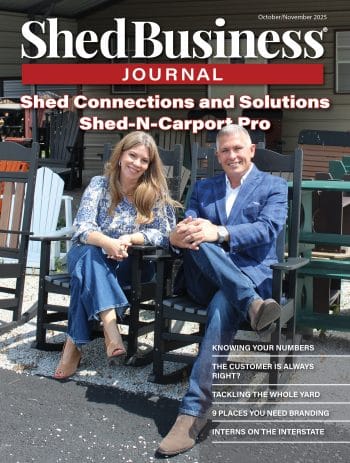
It’s 7:56 pm CST on 11/12/24, and once again, I find myself working late. I can’t express enough how much I love what we do, but like everyone, I could probably do a better job balancing work with home life, exercise, healthy eating, prayer, and reading—you name it.
As I lean back in my chair, I let it all sink in. We’re buying a building!
That’s big news for us. After spending years working from the road or our home, a permanent space is essential as we plan to expand the Shed Geek brand.
Sitting here trying to begin a new article, I battle writer’s block. In my wandering thoughts, I’m reminded that growth always challenges us.
That’s when it hit me: I wonder what the common challenges and timeline for transformation look like for other businesses and even entire industries.
While I wouldn’t call myself a seasoned veteran in understanding industry dynamics, I’ve spent enough time in the shed industry to know that change is constant. Interviewing folks on our podcast who are willing to share their stories has been a fantastic learning experience. The shed industry over the last five years alone has evolved dramatically.
I find myself asking: Is this just the natural course of things? In my 26 years in the workforce, with many of those in this industry, what are the typical changes industries face? After a bit of research, I identified five common challenges or transformations, and I’d like to share my thoughts on how these relate to the shed industry.
1. INCREASED COMPETITION
As an industry grows it typically attracts more associates. Consider the increasing number of dealer locations and larger dealer networks in recent years. Though I don’t have hard data, my extensive travels to nearly 30 states over the past few years give me a solid sense of market changes.
Frequently, I’m asked, “When will the bubble pop?” This question underscores the anxiety about competition potentially leading to conservations such as the possibility of price wars.
The possibility of price wars recalls the airline industry’s fierce battles in the early ‘90s and 2000s. Although this is a different market focused on service over product, it’s a valuable case study to learn from.
Innovation is also key—do we really offer the highest quality sheds possible? Have we invested enough in research and development? We must innovate our designs and improve functionality to shed the stigma of “it’s just a shed.”
Increased competition also underscores the importance of effective branding and maintaining customer awareness. When the customer is considering buying a shed, it is your brand you want at the top of their mind.
2. TECHNOLOGICAL ADVANCES
The last five years have seen technology profoundly transform the shed industry, from 3D modeling and SEO to POS systems and ERP solutions. In an often-conservative industry, incorporating these technologies presents numerous challenges.
Nevertheless, technology mercifully brings efficiencies and enhancements to both products and services. Customers are choosing to shop using technology as a part of the process, even though there are times we may wish to be agnostic to this type of thinking, it is becoming commonplace in the retail market with or without our willingness to participate.
I often talk with manufacturers who are “one-person shows,” although there’s almost always a small team aiding them. Innovations like automation can considerably lessen workloads, freeing valuable time for more productive endeavors.
We’ve seen the benefits of automation, especially in sales and marketing funnels. Automated responses to inquiries can protect your brand’s voice while maintaining a personal touch, which is vital in a consumer-facing industry.
3. REGULATORY AND COMPLIANCE CHALLENGES
Growth frequently invites increased regulatory scrutiny. Those in the RTO (rent-to-own) space know this challenge all too well, dealing with varying state and federal regulations. It’s crucial for companies to remain transparent and compliant, especially as they scale. Labor standards, environmental impact, and consumer protections become increasingly significant concerns as we grow.
The ongoing discussion about 1099 independent contractors versus W-2 employees frequently surfaces. Understanding labor regulations and how they apply to your business structure is essential. Dedicating time to consider these aspects is crucial, as they closely relate to your growth plans and compliance needs.
4. MARKET SATURATION AND CONSOLIDATION
With more players entering the field, concerns about market saturation naturally arise. However, what fascinates me even more is the notion of consolidation.
Customer awareness of shed brands isn’t as prevalent as with companies like John Deere or Ford. Yet, I sense a race to the top within our industry. Who is or will be the John Deere as consolidation continues?
Conversations with companies contemplating sales or expansion reveal that buyouts and consolidation are increasingly likely as any industry matures. The growing interest from private equity firms indicates potential market shifts. Both B2C and B2B sectors are exploring collaborative efforts, integrations, and sometimes M&A (mergers and acquisitions) to enhance service delivery. It’s a fascinating period of transformation, prompting us all to consider how best to adapt and evolve.
5. GLOBALIZATION AND MARKET EXPANSION
“We’re going global, baby!” Or maybe not quite yet. The global footprint of the shed industry is still emerging. Beyond our northern neighbors in Canada and a few operations in the U.K., it’s largely uncharted territory.
Learning from stories like Tom Burbidge’s from Albany Sheds in the U.K. opens our minds to what might be possible.
Reaching beyond domestic boundaries involves navigating logistical differences, varying regulations, and cultural considerations. As much as expanding globally seems like a lofty goal, simply considering this possibility lifts any perceived ceiling on growth within the shed industry.
While I may not know exactly where the industry is heading, I am totally committed to learning and growing alongside it each step of the way. Here’s to what I hope will be the best year yet for our industry.
Let’s move forward together and make it a great one!




